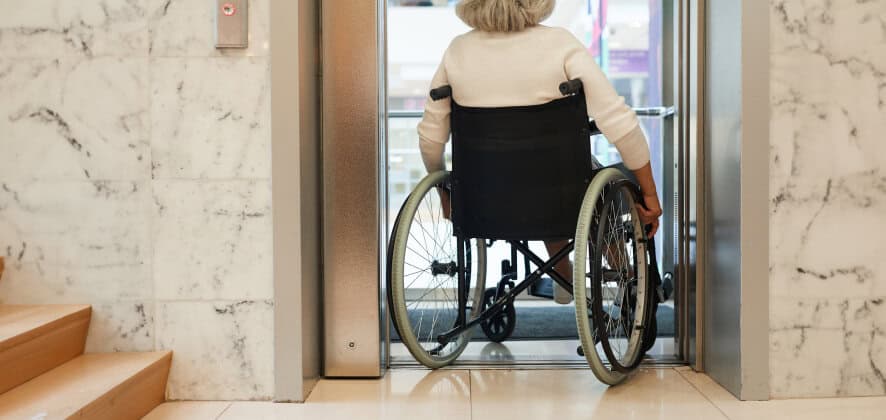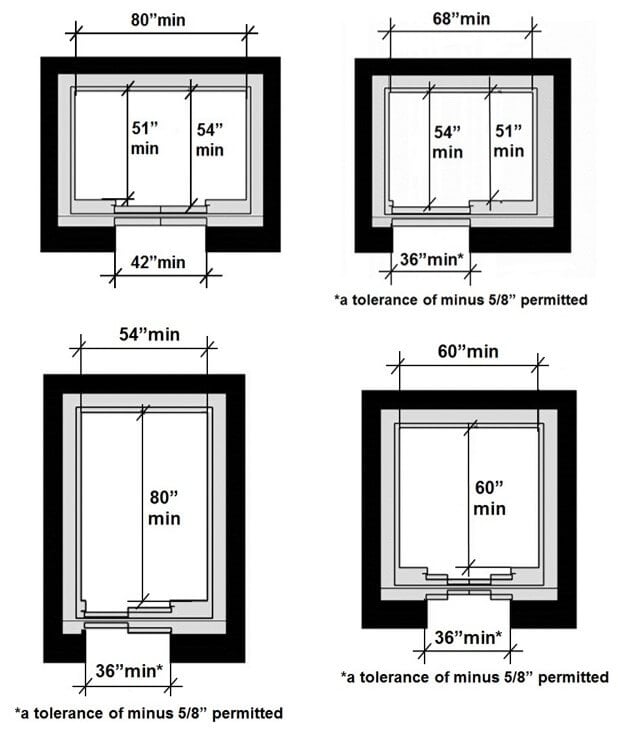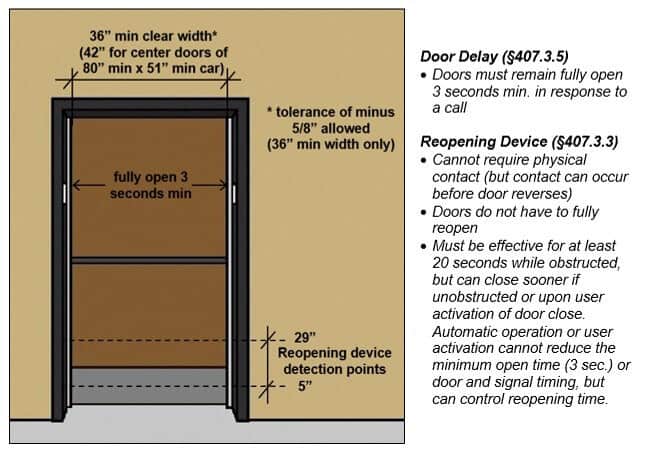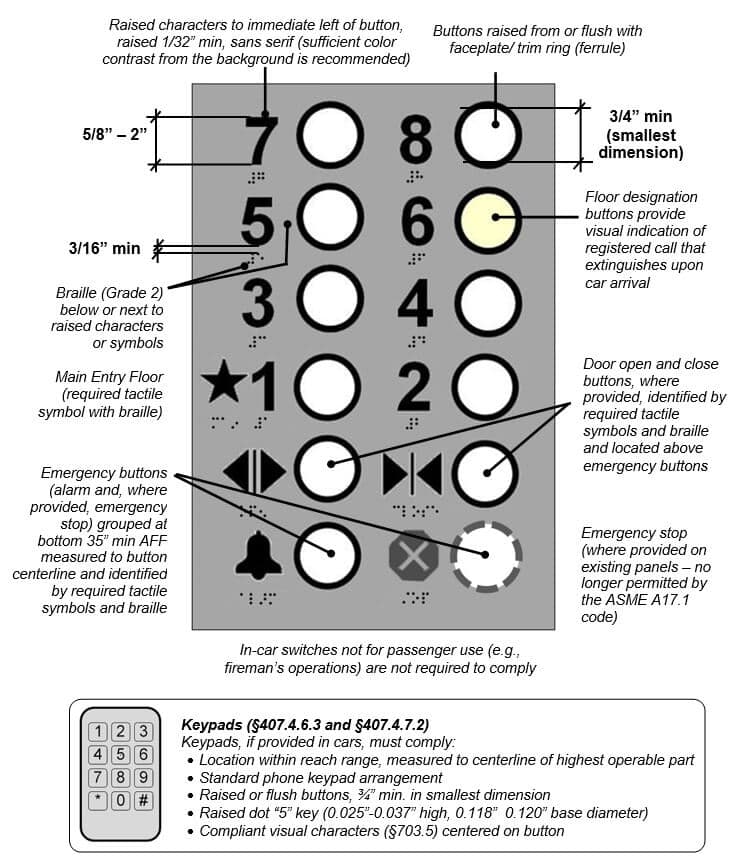ADA Elevator Requirements: Your Complete Guide to ADA Dimensions & Compliant Elevators

The Americans with Disabilities Act (ADA) requires that public and commercial buildings provide reasonable accommodations to people with disabilities so they can access a property. This involves not just installing elevators to allow access to different floors, but includes specific design requirements for elevators to ensure they’re accessible and usable by people with a range of disabilities.
While most modern elevators are manufactured to be ADA compliant, it’s important to know the specific ADA elevator requirements when installing new elevators or remodeling existing ones. A non-ADA compliant elevator risks inconveniencing or even injuring passengers and is likely to incur fines, lawsuits and other penalties.
Here’s what you need to know about ADA elevator requirements.
What Is the American with Disabilities Act?
ADA Elevator Requirements
Additional Accessibility Considerations
Is Your Elevator ADA Compliant?
Ensuring ADA Compliant Elevators
ADA Elevator FAQs
What Is the Americans with Disabilities Act?
Signed into law in 1990, the Americans with Disabilities Act is defined by the U.S. Department of Justice as “a federal civil rights law that prohibits discrimination against people with disabilities in everyday activities. The ADA prohibits discrimination on the basis of disability just as other civil rights laws prohibit discrimination on the basis of race, color, sex, national origin, age, and religion.” Part of that protection against discrimination involves ensuring equal access to facilities and services.
The Department of Justice published revised regulations for Titles II and III of the Americans with Disabilities Act on September 15, 2010 and — as of March 15, 2012 — compliance with the 2010 standards is required for new construction and alterations.
This means that every elevator that moves both passengers and freight, sometimes loosely referred to as “service elevators,” must comply with ADA standards. This covers all elevators in residential or retail facilities that are used by tenants or customers or are used to move furniture, merchandise or other freight.
ADA Elevator Requirements
Under the ADA, facilities that either:
- Are fewer than three stories tall or
- Have fewer than 3,000 square feet per story
are not required to have elevators. However, local state code may have additional requirements, and this exemption doesn’t apply if a building is one of the following:
- Shopping center or shopping mall
- Professional office of a healthcare provider
- Public transportation station, terminal or depot or an airport passenger terminal
Even if a facility isn’t required to have an elevator, it must still provide “reasonable accommodations” so that all floors are readily accessible and usable by individuals with disabilities.
Every building that does have elevators must have at least one that meets accessibility requirements. The full list of ADA requirements is both extremely detailed and extensive, but here’s a overview of major requirements you need to be aware of:
Elevator Location
It is essential that elevators are easily accessible to visitors and should be placed in areas that can be accessed without excessive inconvenience. Even if the elevator has the correct ADA dimensions and features, it will not be compliant if it’s located in a difficult-to-reach area, such as a narrow hallway or space only accessible by stairs.
Elevator Dimensions
In terms of size, the elevator car should be large enough to provide ample space for a wheelchair user to enter through the doors, reach the controls, maneuver within the car and then safely exit the elevator. To be ADA compliant, an elevator must meet minimum the following dimensions:
- The minimum door width for an elevator car is 36 inches.
- The depth of the car must be at least 51 inches,
- The width of the car must be at least 68 inches.
- Elevators with center-opening doors must have a width of at least 80 inches.

Elevator Operation
The elevator must be automatic, which means that it will stop at a designated floor whenever the corresponding button is pressed. The elevator also has to be self-leveling, so that it automatically sets the floor of the car to be level with the destination floor. The elevator doors must automatically open and close, with a minimum open time of at least three seconds. The doors must also have a reopening feature, where closing doors will stop and reopen if the elevator detects that a passenger is entering or leaving the elevator.

Elevator Control Buttons
All ADA compliant elevators must have easily accessible control features with visual, tactile and braille control designators. ADA compliant elevator buttons must be illuminated at all times and centered 42 inches above the floor with a minimum diameter of .75 inches. Call buttons must feature visual signals that display whenever a call is recorded and answered and should indicate the direction in which the elevator is traveling.

Additional Elevator Accessibility Requirements
- Hall lanterns should have a visible and audible signal provided at each hoistway entrance to indicate which elevator car is answering a call. Audible signals must sound once for the up direction and twice for the down direction or have verbal annunciators that say “up” or “down.”
- Elevator floors must comply with ADA regulations for all ground surfaces. The floor must be stable, firm and slip resistant. If there’s carpet, it needs to be attached to the floor, and any cushions, pads or backing must be firm.
- Every elevator car must have emergency communications in case the car stops and passengers need to call for assistance. Any two-way communication must be tactilely and visually accessible and understandable by both deaf and blind persons.
- Handrails within the car are required at certain heights, with a standard of 30 inches high.
- Braille plates are required on all entrance jams, as well as in the hall stations.
Is Your Elevator ADA Compliant?
To thoroughly review your elevators’ compliance, we recommend visiting the New England ADA Center’s website, which has a complete list of checklists to measure ADA compliance, including a complete Priority 2 Access to Goods & Services checklist with a section for elevators.
For ADA requirements of other doors and door hardware, we recommend The Flying Locksmiths post, “Is my Commercial Space ADA compliant?“.
Download the ADA checklist in your choice of format at this direct link.
Ensuring ADA Compliant Elevators
If you’re unsure about whether the elevators in your buildings are up to code, ask your service provider to survey the elevators and submit a list of recommended changes. Not only must your elevators be ADA compliant, they must abide by relevant state and national safety codes. Most codes are set by the American Society of Mechanical Engineers to provide consistency in construction, installation and safety.
Stanley Elevators can help ensure that you stay compliant in any of the states we work in. You can trust our decades of experience to keep you compliant with the most rigorous safety and accessibility requirements. Contact us with any questions you have about safety or compliance, and for additional information about state and national elevator safety regulations, see our service page on safety codes.
ADA Elevator FAQs
What is ADA compliance?
The American Disabilities Act is a collection of standards set by the U.S. Department of Justice and the Department of Transportation. In regards to buildings and elevators, ADA compliance is intended to prevent discrimination against people with disabilities by defining a set of standards where they can enter the building and make use of any facilities or services.
Do elevators have to be ADA compliant?
If an elevator is classified by the referenced elevator safety code (ASME A17.1) as a passenger elevator, then it must meet the ADA standards. This includes service elevators and Limited-Use/Limited-Application (LULA) elevators.
Do I need to install an elevator in my building?
If your building is fewer than three stories tall or has fewer than 3,000 square feet per story, then you do not need to install an elevator unless the facility:
- Is shopping center or shopping mall
- Is the professional office of a healthcare provider
- Is a public transportation station, terminal or depot or an airport passenger terminal.
You must still make reasonable accommodations so that people with disabilities can access the building and its services. If you are required to install an elevator, then you must have at least one elevator that is ADA compliant.
What does “readily achievable” mean?
Readily achievable refers to any modifications that can be easily accomplished with little to no inconvenience or cost. The factors defining the readily achievable state involve the type and cost of the adjustment as well as the financial means of the owner.
How can elevators be considered ADA compliant?
To be compliant, the elevator must meet the exact ADA Accessibility Standards as laid out by the U.S. Access Board. All modern elevators are manufactured to meet current ADA specifications, though care must be taken to make sure that the area around the elevator is compliant and that the elevator is able to operate as intended.
Who can make repairs/updates to ensure compliance?
If you have an existing elevator that may not meet ADA standards, an elevator maintenance and service company can review your elevator to see what updates and repairs are needed. Be sure to choose a company that is familiar with both state and federal standards, has the experience to thoroughly inspect the elevator and can provide convenient, local service.